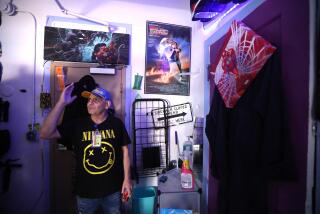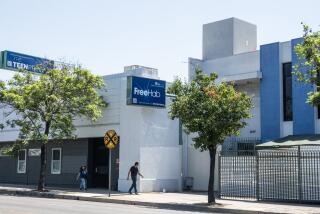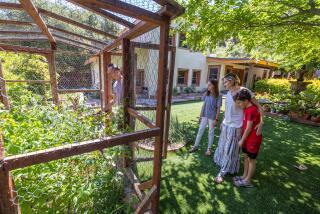AIDS Patient Finds a Haven at Truax House
Mark Ferrara sat by the window, smoking cigarettes. Through the plume of smoke, he watched planes taking off from nearby Lindbergh Field. He said the noise didn’t bother him.
To see planes taking off meant that people were alive, taking trips, seeing loved ones. And the smoke, well, he said, it’s one of life’s few remaining pleasures. Give him smoke, you give him life. And don’t you dare take it away.
Ferrara, 32, has AIDS. He is pallid and frail and doesn’t know how much longer he has to live. He sat near the television, watching “The Young and the Restless.” Before too long, he would tune in “One Life to Live.” Not a day goes by that he doesn’t watch both.
At the moment, Ferrara is the only tenant of Truax House, a residential hospice center for AIDS patients that opened last month. It is named in honor of Dr. Brad Truax, who died of AIDS-related complications late last year. Truax’s portrait hangs in the foyer of the colonial-style home, which is almost a century old. The house is high on a hill at the corner of Laurel and Union streets, near Balboa Park.
As Ferrara said, “You can see the world from here.”
Dennis Wilson, housing director of the AIDS Assistance Fund, said the role of Truax House is “to provide a secure, homelike setting for victims of AIDS and ARC (AIDS-related complex). Here, they don’t have to worry about being kicked out. They won’t be evicted because of their sickness, or because they’re gay.”
Before too long, the house, which has a capacity of 10 residents, will be full--full of men like Ferrara who are dying, who have weeks or days to live and want a
haven in which to spend their final moments.
Wilson said it’s important that the house reflect the spirit of Truax, who had been a leader in the gay community and the Democratic Party, a “man who cared about decency and human rights.” Truax never lived in the house, which was donated by the city of San Diego through the San Diego Housing Commission.
Funding and Donations
Wilson said that funding for Truax House comes from the Office of AIDS, a state agency, as well as the county. The furnishings in the four-bedroom home, all of which were donated, are worth about $100,000, including $5,000 worth of paintings. The house itself, Wilson said, is valued at more than $1 million.
Truax House is managed by the AIDS Assistance Fund, which was set up five years ago to deal with the needs of “clients” who have AIDS. Wilson said the fund provides a food bank, a chaplaincy program and counseling. He said the requirements for tenants of Truax House are “mobility . . . they have to be ambulatory. We do have nurses for each client, but we’re not set up to be a 24-hour care facility. If their conditions worsen or become severe, they go to a hospital.”
Wilson said that Truax House is one of five such hospices in the county, but it is different in being limited to 10 residents and in offering “more of a homelike setting.” He said that residents are required to pay rent of $325 a month.
‘Reduces the Stress’
“I love it here,” Ferrara said. “The atmosphere is what I need. It’s peaceful and relaxed. The worst part of AIDS for me is stress. This place reduces the stress.
“I was diagnosed as having AIDS in 1987 and moved (to San Diego) in February of last year. I had to leave New York, where I’m from, because the center where I was living didn’t want an AIDS patient. The worst for me was March and April of ‘88, when I had a temperature of 104 and came down with tuberculosis and viral pneumonia.
“Right now, I need transfusions, but my blood levels are too low, so they won’t give them to me. I can’t take AZT (which reduces the effects of AIDS) for the same reason. I’m very depressed, but the anti-depressants I’m taking won’t take effect for months.
“I hate the depression this brings on. I hate the funerals. They get me very upset. I like to be with people who have AIDS--they understand--but I hate to talk about AIDS. Acquired immune deficiency syndrome. Somehow, just hearing about it makes it worse.”
Volunteer Has Been There
Craigory Jones, 25, works in Truax House as a volunteer. His face is narrow and gaunt and punctuated by a large earring that dangles from his left ear. He was diagnosed as having AIDS three years ago. At one time, he was in a wheelchair for six months. But now, aside from being stick-figure thin, he bears no overt signs of illness.
“During my worst period, I was on a respirator,” Jones said. “I had collapsed lungs. The nerves in my legs were shot. I couldn’t really move my legs. The worst of this for me has been the cycles you go through--shame, denial, frustration, anger.
“I was in the Army at one time. I’m more than just a gay male,” he added with a laugh. “I had two wives, and I have two children, ages 4 and 6. One marriage was annulled after two weeks, but the other one lasted a while. I was out of the closet for a year before I learned I have AIDS.
“My children know that I have AIDS, and I’ve tried to explain it--how and why I got it. I’ll take a stick to them if they ever become gay”--he laughed--”although I don’t feel regret about coming out, despite the illness.
“When I first learned I had it, I did feel that--you look for something to blame it on. But if there’s anything positive about AIDS, it’s that it puts you in closer touch with what life is all about. It makes you appreciate the life you have left.”
More to Read
Sign up for Essential California
The most important California stories and recommendations in your inbox every morning.
You may occasionally receive promotional content from the Los Angeles Times.









